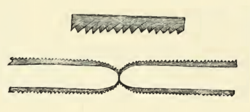Biology:Tetragraptus approximatus
| Tetragraptus approximatus | |
|---|---|

| |
| Illustration of Tetragraptus approximatus | |

| |
| Original illustrations of Tetragraptus approximatus by Nicholson (1873). At the top is a magnified section of the stipes. A complete specimen is illustrated below. | |
| Scientific classification | |
| Domain: | Eukaryota |
| Kingdom: | Animalia |
| Phylum: | Hemichordata |
| Class: | Pterobranchia |
| Order: | †Graptoloidea |
| Family: | †Dichograptidae |
| Genus: | †Tetragraptus |
| Species: | †T. approximatus
|
| Binomial name | |
| †Tetragraptus approximatus Nicholson, 1873
| |
Tetragraptus approximatus is a species of dichograptid graptolite belonging to the genus Tetragraptus. It existed during the Floian Age (477.7 million years ago) of the Ordovician. It is an important index fossil in biostratigraphy.
Description
The general outline of each Tetragraptus approximatus colony (rhabdosome) is highly distinctive. It resembles a long narrow letter H or X. The central process (the funicle) is about 2.5 mm (0.098 in) long, each end bifurcating at right angles with each other. Each pair of branches (stipes) curve away sharply from the ends of the funicle then run more or less parallel with each other at a distance of 5 to 8 mm (0.20 to 0.31 in) apart. Each of the stipes can reach more than 45 mm (1.8 in) in length, with approximately ten cup-like structures (thecae) for every 10 mm (0.39 in) of the stipes. The thecae are tilted at a 45° angle to the axis.[1][2]
Taxonomy
Tetragraptus approximatus is classified under the genus Tetragraptus of the family Dichograptidae.[3][4] It was first described by the British paleontologist Henry Alleyne Nicholson in 1873 from specimens recovered from Lévis, Quebec, Canada .[2]
Distribution
Tetragraptus approximatus is found worldwide. It has been identified in graptoliferous rocks from Australia , New Zealand, Canada (Newfoundland), the United States (Texas ), Kazakhstan, Russia (Taimyr), China , South America, Norway , and Sweden. It is unknown, however, in areas which lack coeval graptoliferous rocks like the United Kingdom , Spitsbergen, and Africa.[5]
Biostratigraphy
Tetragraptus approximatus is used in biostratigraphy as an index fossil. Its first appearance at the GSSP section of the Diabasbrottet Quarry in Västergötland, Sweden is defined as the beginning of the Floian Age (477.7 million years ago) of the Ordovician.[5]
References
- ↑ Reuben J. Ross; William B.N. Berry (1963). "Ordovician Graptolites of the Basin Ranges in California, Nevada, Utah, and Idaho". Geological Survey Bulletin (1134): 5–9. https://books.google.com/books?id=WktjAAAAIAAJ&q=Nicholson+1873+Tetragraptus.
- ↑ Jump up to: 2.0 2.1 Henry Alleyne Nicholson (1873). "On some Fossils from the Quebec Group of Point Lévis, Quebec". Annals and Magazine of Natural History. 4th Series 11 (62): 133–143. doi:10.1080/00222937308696778. https://archive.org/details/s4annalsmagazine11londuoft.
- ↑ "Tetragraptus (Tetragraptus) approximatus Nicholson, 1873". New Zealand Organisms Register (NZOR). http://demo.nzor.org.nz/names/c05a245d-d0f0-4cca-9000-c28818395c91.
- ↑ William Noel Benson; Alexander Robert Keble (1936). "On some Fossils from the Quebec Group of Point Lévis, Quebec". Transactions and Proceedings of the Royal Society of New Zealand 65: 244–294. http://rsnz.natlib.govt.nz/volume/rsnz_65/rsnz_65_00_002570.pdf.
- ↑ Jump up to: 5.0 5.1 Stig M. Bergström; Anita Löfgren; Jörg Maletz (2004). "The GSSP of the Second (Upper) Stage of the Lower Ordovician Series: Diabasbrottet at Hunneberg, Province of Västergötland, Southwestern Sweden". Episodes 27 (4): 265–272. doi:10.18814/epiiugs/2004/v27i4/005. http://www.stratigraphy.org/GSSP/file41.pdf.
Wikidata ☰ Q7706514 entry
 |

